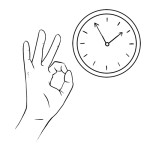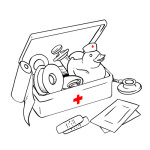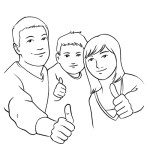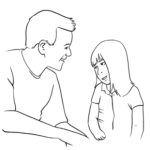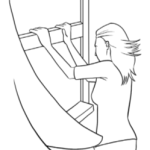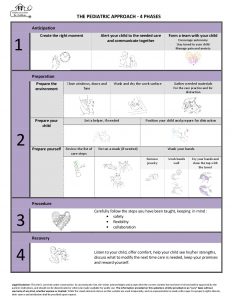A key component of the pediatric approach is a 4 stage method (Anticipate, Prepare, Procedure, Recovery) that is very effective in helping children, of all ages, adapt to care needs. It can be used in the hospital, at home or in any other environment where care is being provided.
The pediatric approach is especially helpful with children who have care needs that are:
- specialized (eg, peritoneal dialysis) or
- frequent (eg, daily ostomy care) or
- potentially painful or uncomfortable (eg, tracheostomy suctioning) or
- long term.
How does the pediatric approach work?
Parents and caregivers work as a team with their child with the goals of:
- encouraging and affirming the autonomy of the child by providing reasonable choices;
- recognizing the child’s strengths, even in challenging situations;
- ensuring that the child feels safe and secure, often through positioning and distraction;
- safe completion of the necessary care;
- minimizing stress and anxiety in the child (short term and long term!).
We recommend that you speak with your healthcare team if your child is showing signs of stress or any of the following:
- crying a lot;
- not staying still during procedures;
- feeling very angry, worried or sad;
- refusing care.
Please don’t ignore these behaviours; if they are present, it is best for your child to deal with them sooner rather than later. Your child may benefit from the specialized services of a professional experienced in helping children develop coping skills, such as a nurse, child life worker, child psychologist or a physician. Learn more about specific behaviour problems, suggested do’s and don’ts here.
Read more here about the pediatric approach and how to use it with your child.
Phase 1. Anticipation
You and your child are a team! Children adjust to even very complicated care at home when they feel supported and safe. Invest in these tips to help your child avoid unwanted reactions such as: anxiety, stress or refusal of care.
A. Create the right moment
Integrate the care in a routine: for care that children need regularly, schedule the care so that it fits with your family’s routines as much as possible. Find specific tips in the section Prepare yourself, Organizing your day.
A predictable routine is soothing to children and helps them feel secure, for example: planning care after a calm game, before mealtime.
Aim to respect your child’s basic needs before doing a procedure, for example: offer a drink or snack, change diaper/have child use toilet, let your child have a nap if they are tired.
B. Alert your child to the needed care and communicate together
Depending on your child’s age and developmental level, let your child know that a specific care is going to take place. In general, younger children benefit from shorter times (minutes beforehand) between the “alert” and the procedure, while older children adapt better when they know further in advance that care will be provided (hours before hand). Ideally, when care becomes part of the family routine, children will easily know when it will take place.
| Infants | Toddlers | Preschoolers | School-aged | Adolescents |
| minutes | minutes | hours | hours | days |
This is a good time to prepare your child for what he/she can expect to happen next.
C. Form a team with your child
| Empower your child | = | Listen | + | Comfort and distract |
+ | Position |
To ensure comfort to help your child feel secure during treatments, you can mix a variety of strategies. You and your child can choose the strategies that fit best. As your child develops and grows, be prepared to try new strategies that reflect your child’s changing needs.
Encourage autonomy: Be aware of and offer realistic choices to your child. Letting your child decide is a key way to empower your child.
Stay tuned to your child: You know your child best. Try to anticipate your child’s reactions and encourage your child to express his/her feelings. Medical (therapeutic) play is an effective way to do this, to help your child adapt to the needed care.
For example, your child may wish to participate in the care or may be irritable or anxious prior to a procedure, or may try to delay the needed care in some way. Through medical play, you can allow your child to express these feelings and then respond to them in a simple, clear way.
Manage pain and anxiety: Each child is unique in their perception of pain and anxiety. Some children have more pain with repeated procedures and other children find the same treatment less painful over time. Behavioural techniques, such as using distraction and positioning can greatly increase your child’s comfort during procedures. If your child is still having discomfort, ask your healthcare team about other options, including medications or special creams that could minimize pain during home treatments.
Phase 2. Preparation
A. Prepare the environment
Choose a place where care can be provided on a regular basis. Ideally, this location should be:
- quiet and clean;
- not the child’s crib or bed (leave the sleeping place as a secure site for your child);
- close to the sink or toilet, if needed for the type of care;
- keep a simplified list of the care practice close to where you will provide the care. This can serve as a reminder, improving safety.
In advance, prepare the place where care will be given:
Before you position your child to receive the care, prepare anything else that can be done in advance. Organize your supplies and equipment, close at hand.
B. Prepare your child
| Get a helper, if needed | Position your child and prepare for distraction |
 |
 |
| Get the help of a 2nd person, if needed; otherwise minimize the number of people present, unless the child requests it. Make sure your helper knows how to help! Let your child know what the helper will do. Be specific in the tasks that you give to the helper. Provide feedback afterwards so that the helping can improve each time. | Position your child and begin to use the selected distraction method. |
C. Prepare yourself
As much as is possible, choose a time to give the care when you are focused, calm and well-rested.
| Review the list of care steps | Put on a mask (if required by the type of care or if you are sick) |
Wash your hands |
||
 |
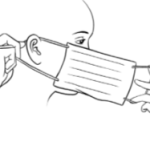 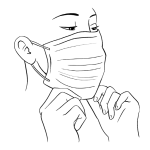 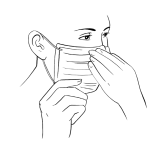 |
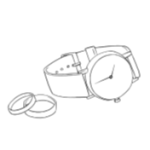 |
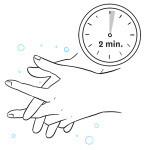  |
 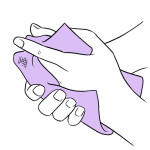 |
| Use a summary checklist. | Position the mask over the nose and under the chin. A standard mask should be changed every 30 minutes. | Remove jewelry. | Scrub well with soap for a minimum of 2 minutes. Rinse. | Dry your hands with a clean disposable towel and then shut off the tap using the towel. |
| **For care that requires sterile technique, open packages after washing your hands, just prior to starting the procedure. | ||||
Now that:
- your materials and equipment are ready,
- you have a helper, if needed,
- your child is optimally positioned and has chosen a method of distraction,
- pre-procedure medication, if required has been given,
You are almost ready to start the specific care practice.
Take the opportunity to encourage and praise your child, especially recognizing choices that your child has made. Acknowledge and praise your child’s strengths and collaboration. For example “Thank you for holding your arm out, nice and straight. That will help the treatment go in easier. The pink pillow underneath that you chose is helping your arm feel comfortable. Good choice! Ready to watch the Dora video? You picked the episode where Dora goes to school – that’s one of my favourites too. Let’s turn it on.” (child could help, pushing the start button).
Phase 3. Procedure

As you begin the procedure, carefully follow the steps that you have been taught. Work as a team with your child.
Keep in mind 3 key concepts:
- Safety: Carefully review and follow the care practice steps as you have been taught. Ask your healthcare team if your child requires any unique adaptations; if required, make note of these.
- Flexibility: Care is best provided when the person doing the care remains alert and responsive to the child’s needs. Check to make sure that your child is comfortable and well positioned; if not, make adjustments. Is the distraction strategy working? If not, another form of distraction might be needed before proceeding with the care practice.
Follow the pace of your child, taking short breaks if needed. - Collaboration: When you communicate well with your child and he/she feels safe, then you have formed an effective team! Depending on the specific needs of your child, try these “team building” tips:
- Reassure your child
- Tell your child you will stay present.
- Stay close to your child, stroke your child’s head, hands or back to comfort.
- Depending on your child, talk about another topic of interest or describe the procedure that is about to happen.
- Avoid phrases such as: “I’m sorry”, “it will be over soon”, and “it will be okay”.
- Acknowledge your child’s emotions and reactions, be patient and aim to recognize your child’s strengths
- It is important to be honest with children about the challenges of care.
- Help your child see his/her own strengths. Offer specific feedback and encouragement. For example, “You are so brave, even when you are sad, you do not move. It’s hard but you stayed still and that made it easier to finish the treatment. Thank you!”
- Help your child differentiate between sensations so that they can communicate their feelings more clearly and also to understand that the entire process is not painful or difficult – perhaps only a small portion of the care is unpleasant…
- For example, Taking a new medication by mouth: “What sort of taste is it? Some other kids say it tastes like… what do you think?”
- For example, Cleaning the skin before a procedure: “That’s cold, isn’t it? Do you like that tingly feeling from the cold? It feels like going outside to play in the snow!”
- Reassure your child
Phase 4. Recovery
The treatment is finished! Wash your hands again! It is important to “wrap up” on a positive note. Be prepared to recognize the challenges faced and also to provide positive feedback to your child, recognizing his/her strengths. Each time care is provided, you and your child learn how to improve the experience for the next time – that’s teamwork!
- Listen to (and ask!) what your child says about the parts of the procedure that he/she found difficult or painful.
- Comfort your child: hugs, “high fives”, smiles and kisses. Especially if your child was angry, anxious or sad – reassure your child that these reactions are normal and with practice, will improve. Take the time to positively reinforce (reward) your child’s collaboration with the care practice – praise works best.
- Help your child see his/her specific strengths that make the care experience more positive. For example, child stayed still even though he/she cried; child participated in distraction technique even though he/she felt anxious… see more ideas in recognizing your child’s strengths.
- Discuss with your child what might be done in the same way or differently to help the next time: the same position? another distraction strategy?
- Keep your promises. If you have negotiated a reward, like a special activity or game, do not forget: your kids will not forget! The best reward is always a parent’s praise, and the shared pride of successful completion of care.
- Reward yourself too! Providing care to your child at home is a major accomplishment. Be proud of your growing capabilities in providing the care safely, effectively and in a positive manner. Bravo!









